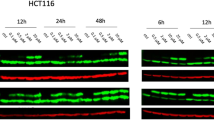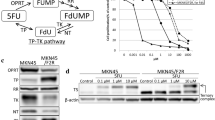Abstract
Purpose
Thymidylate synthase (TS) over-expression is widely accepted as a major molecular mechanism responsible for 5-fluorouracil (5-FU) and tomudex (TDX) resistance. In this study, the importance of TS in 5-FU and TDX resistance was evaluated.
Methods
The sensitivity of TS-over-expressing 5-FU (3) and TDX (3) resistant cell lines to 5-FU and TDX was analysed. The cross-resistance between 5-FU and TDX resistant cell lines was determined. The relationship between p53 and NF-κB status and the sensitivity to 5-FU and TDX was evaluated.
Results
Compared to relevant parental sensitive cell lines, the 5-FU resistant cell lines were highly cross-resistant to TDX (over 20,000-fold). In contrast, over-expression of TS did not significantly confer 5-FU resistance on the TDX resistant cell lines (0.8- to 1.3-fold). Thymidine (20 μM) rescue induced TDX resistance in TDX sensitive cell lines (over 10,000-fold) but only moderately influenced 5-FU sensitivity in 5-FU sensitive cell lines (1.1- to 2.4-fold). Uridine moderately protected one cancer cell line (RKO) from 5-FU-induced, but not TDX-induced, cytotoxicity. NF-κB transfected MCF-7 and p53 knockout HCT116 cells were resistant to 5-FU (4.4- and 2.4-fold, respectively) but not to TDX. TS protein expression in NF-κB transfected and p53 knockout cell lines was comparable to the relevant parental cell lines.
Conclusion
In some cancer cell lines, TS-independent molecular events may play a key role in 5-FU resistance. Loss of p53 function and NF-κB over-expression may be involved in TS-independent 5-FU chemoresistance in some cancer cell lines.


Similar content being viewed by others
Abbreviations
- 5-FU:
-
5-Fluorouracil
- dTMP:
-
Deoxythymidine monophosphate
- dTTP:
-
Deoxythymidine triphosphate
- dUMP:
-
Deoxyuridine monophosphate
- dUTP:
-
Deoxyuridine triphosphate
- FdUMP:
-
5-Fluorodeoxyuridine monophosphate
- MTT:
-
Tetrazolium-based semiautomated colorimetric
- NF-κB:
-
Nuclear factor-kappa B
- TdR:
-
Thymidine
- TDX:
-
Tomudex
- TS:
-
Thymidylate synthase
- Urd:
-
Uridine
References
Boyer J, McLean EG, Aroori S, Wilson P, McCulla A, Carey PD, Longley DB, Johnston PG (2004) Characterization of p53 wild-type and null isogenic colorectal cancer cell lines resistant to 5-fluorouracil, oxaliplatin, and irinotecan. Clin Cancer Res 10:2158–2167
Bunz F, Hwang PM, Torrance C, Waldman T, Zhang Y, Dillehay L, Williams J, Lengauer C, Kinzler KW, Vogelstein B (1999) Disruption of p53 in human cancer cells alters the responses to therapeutic agents. J Clin Invest 104:263–269
Chu E, Callender MA, Farrell MP, Schmitz JC (2003) Thymidylate synthase inhibitors as anticancer agents: from bench to bedside. Cancer Chemother Pharmacol 52(Suppl 1):S80–S89
Codacci-Pisanelli G, Kralovanszky J, van der Wilt CL, Noordhuis P, Colofiore JR, Martin DS, Franchi F, Peters GJ (1997) Modulation of 5-fluorouracil in mice using uridine diphosphoglucose. Clin Cancer Res 3:309–315
Copur S, Aiba K, Drake JC, Allegra CJ, Chu E (1995) Thymidylate synthase gene amplification in human colon cancer cell lines resistant to 5-fluorouracil. Biochem Pharmacol 49:1419–1426
Ishibiki Y, Kitajima M, Sakamoto K, Tomiki Y, Sakamoto S, Kamano T (2003) Intratumoural thymidylate synthase and dihydropyrimidine dehydrogenase activities are good predictors of 5-fluorouracil sensitivity in colorectal cancer. J Int Med Res 31:181–187
Johnston PG, Behan KA, Allegra CJ, Drake JC (1995) Fluorouracil: active in ZD1694 (tomudex)-resistant cell lines with markedly elevated thymidylate synthase levels. J Natl Cancer Inst 87:1558–1559
Johnston PG, Benson AB, Catalano P, Rao MS, O’Dwyer PJ, Allegra CJ (2003) Thymidylate synthase protein expression in primary colorectal cancer: lack of correlation with outcome and response to fluorouracil in metastatic disease sites. J Clin Oncol 21:815–819
Johnston PG, Lenz HJ, Leichman CG, Danenberg KD, Allegra CJ, Danenberg PV, Leichman L (1995) Thymidylate synthase gene and protein expression correlate and are associated with response to 5-fluorouracil in human colorectal and gastric tumors. Cancer Res 55:1407–1412
Kufe DW, Major PP (1981) 5-Fluorouracil incorporation into human breast carcinoma RNA correlates with cytotoxicity. J Biol Chem 256:9802–9805
Longley DB, Harkin DP, Johnston PG (2003) 5-fluorouracil: mechanisms of action and clinical strategies. Nat Rev Cancer 3:330–338
Lonn U, Lonn S (1986) DNA lesions in human neoplastic cells and cytotoxicity of 5-fluoropyrimidines. Cancer Res 46:3866–3870
Maxwell PJ, Longley DB, Latif T, Boyer J, Allen W, Lynch M, McDermott U, Harkin DP, Allegra CJ, Johnston PG (2003) Identification of 5-fluorouracil-inducible target genes using cDNA microarray profiling. Cancer Res 63:4602–4606
Meyers M, Wagner MW, Hwang HS, Kinsella TJ, Boothman DA (2001) Role of the hMLH1 DNA mismatch repair protein in fluoropyrimidine-mediated cell death and cell cycle responses. Cancer Res 61:5193–5201
Mirjolet JF, Barberi-Heyob M, Merlin JL, Marchal S, Etienne MC, Milano G, Bey P (1998) Thymidylate synthase expression and activity: relation to S-phase parameters and 5-fluorouracil sensitivity. Br J Cancer 78:62–68
Mirjolet JF, Didelot C, Barberi-Heyob M, Merlin JL (2002) G(1)/S but not G(0)/G(1)cell fraction is related to 5-fluorouracil cytotoxicity. Cytometry 48:6–13
Pinedo HM, Peters GF (1988) Fluorouracil: biochemistry and pharmacology. J Clin Oncol 6:1653–1664
Plumb JA, Milroy R, Kaye SB (1989) Effects of the pH dependence of 3-(4,5-dimethylthiazol-2-yl)-2,5-diphenyl-tetrazolium bromide-formazan absorption on chemosensitivity determined by a novel tetrazolium-based assay. Cancer Res 49:4435–4440
Popat S, Matakidou A, Houlston RS (2004) Thymidylate synthase expression and prognosis in colorectal cancer: a systematic review and meta-analysis. J Clin Oncol 22:529–536
Pritchard DM, Watson AJ, Potten CS, Jackman AL, Hickman JA (1997) Inhibition by uridine but not thymidine of p53-dependent intestinal apoptosis initiated by 5-fluorouracil: evidence for the involvement of RNA perturbation. Proc Natl Acad Sci USA 94:1795–1799
Salonga D, Danenberg KD, Johnson M, Metzger R, Groshen S, Tsao-Wei DD, Lenz HJ, Leichman CG, Leichman L, Diasio RB, Danenberg PV (2000) Colorectal tumors responding to 5-fluorouracil have low gene expression levels of dihydropyrimidine dehydrogenase, thymidylate synthase, and thymidine phosphorylase. Clin Cancer Res 6:1322–1327
Sobrero A, Kerr D, Glimelius B, Van Cutsem E, Milano G, Pritchard DM, Rougier P, Aapro M (2000) New directions in the treatment of colorectal cancer: a look to the future. Eur J Cancer 36:559–566
Touroutoglou N, Pazdur R (1996) Thymidylate synthase inhibitors. Clin Cancer Res 2:227–243
Van Cutsem E (1999) Raltitrexed (Tomudex) in combination treatment for colorectal cancer: new perspectives. Eur J Cancer 35(Suppl 1):S1–S2
van der Wilt CL, Backus HH, Smid K, Comijn L, Veerman G, Wouters D, Voorn DA, Priest DG, Bunni MA, Mitchell F, Jackman AL, Jansen G, Peters GJ (2001) Modulation of both endogenous folates and thymidine enhance the therapeutic efficacy of thymidylate synthase inhibitors. Cancer Res 61:3675–3681
van Triest B, Pinedo HM, van Hensbergen Y, Smid K, Telleman F, Schoenmakers PS, van der Wilt CL, van Laar JA, Noordhuis P, Jansen G, Peters GJ (1999) Thymidylate synthase level as the main predictive parameter for sensitivity to 5-fluorouracil, but not for folate-based thymidylate synthase inhibitors, in 13 nonselected colon cancer cell lines. Clin Cancer Res 5:643–654
Vokes EE, Goh BC, Bertucci D, Vogelzang NJ, Mani S, Ratain MJ (1999) A phase I study of raltitrexed and paclitaxel given every 3 weeks to patients with solid tumors. Cancer 86:528–532
Wang W, Cassidy J (2003) Constitutive nuclear factor-kappa B mRNA, protein overexpression and enhanced DNA-binding activity in thymidylate synthase inhibitor-resistant tumour cells. Br J Cancer 88:624–629
Wang W, Cassidy J, O’Brien V, Ryan KM, Collie-Duguid E (2004) Mechanistic and predictive profiling of 5-fluorouracil resistance in human cancer cells. Cancer Res 64:8167–8176
Wang W, Collie-Duguid E, Cassidy J (2002) Cerivastatin enhances the cytotoxicity of 5-fluorouracil on chemosensitive and resistant colorectal cancer cell lines. FEBS Lett 531:415–420
Wang W, Marsh S, Cassidy J, McLeod HL (2001) Pharmacogenomic dissection of resistance to thymidylate synthase inhibitors. Cancer Res 61:5505–5510
Wang W, McLeod HL, Cassidy J (2003) Disulfiram-mediated inhibition of NF-kappaB activity enhances cytotoxicity of 5-fluorouracil in human colorectal cancer cell lines. Int J Cancer 104:504–511
Acknowledgments
This work is supported by North Glasgow University Hospital NHS Trust West Research Endowment.
Author information
Authors and Affiliations
Corresponding author
Rights and permissions
About this article
Cite this article
Wang, W., McLeod, H.L., Cassidy, J. et al. Mechanisms of acquired chemoresistance to 5-fluorouracil and tomudex: thymidylate synthase dependent and independent networks. Cancer Chemother Pharmacol 59, 839–845 (2007). https://doi.org/10.1007/s00280-006-0384-5
Received:
Accepted:
Published:
Issue Date:
DOI: https://doi.org/10.1007/s00280-006-0384-5




